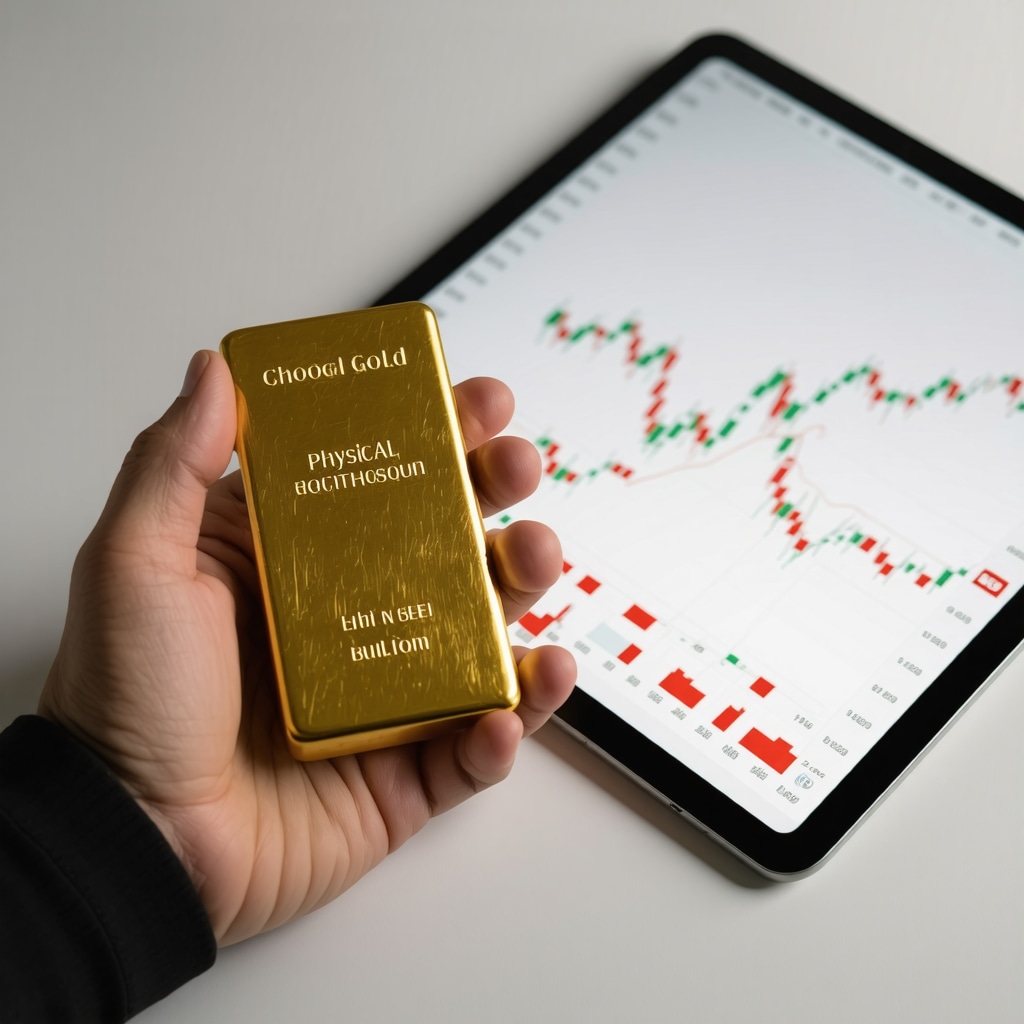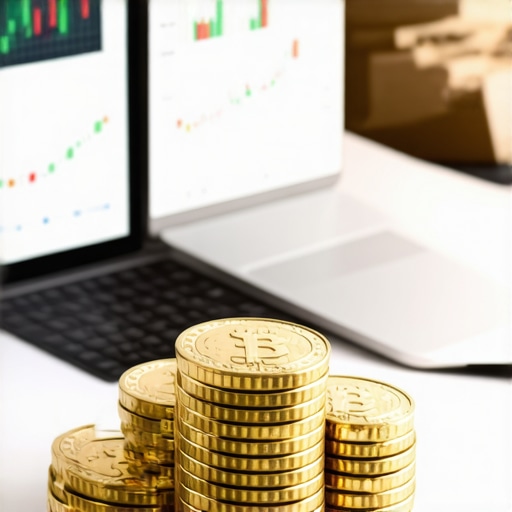How My Gold Investment Journey Began: Bullion or ETFs?
When I first ventured into gold investments, I was overwhelmed by the array of choices. The two most popular options—gold bullion and gold ETFs—stood out, but which one was right for me? My journey started with a simple purchase of a small gold coin, feeling its weight and shine, which gave me a tangible sense of security. However, as I dived deeper, ETFs caught my attention for their convenience and liquidity.
Why I Fell for Physical Gold Bullion: Tangible Security and Long-Term Value
There’s something uniquely reassuring about holding physical gold bars or coins. I remember visiting a trusted dealer and carefully selecting a few well-crafted gold bars that met my criteria for quality and security. The tactile experience, combined with the historical reliability of bullion as a hedge against inflation and economic uncertainty, convinced me that physical gold has an irreplaceable role in my portfolio. Plus, the fact that bullion is universally recognized and accepted gave me peace of mind during turbulent market conditions.
Exploring Gold ETFs: Convenience and Market Exposure Without the Hassle
Despite my fondness for physical gold, I also ventured into gold ETFs to diversify. ETFs offer easy access to gold price movements without the need to store or insure physical assets. This flexibility was especially attractive during times when I wanted quick liquidity or to respond swiftly to market trends. However, I learned that ETFs come with management fees and lack the emotional reassurance of holding gold in hand. For those interested, the ultimate guide to gold ETFs is a fantastic resource to understand how they work and their pros and cons.
Is Investing in Gold Bullion or ETFs Better for My Financial Goals?
This question kept me pondering for a while. The answer, I realized, depends on your investment objectives and risk tolerance. Bullion suits investors prioritizing tangible assets and long-term wealth preservation, while ETFs appeal to those favoring liquidity, ease of trading, and lower entry barriers. I found that combining both types in my portfolio balanced security and flexibility effectively.
For anyone navigating these options, I recommend reading about various gold investment types to build a well-rounded understanding.
Lessons Learned and Tips From My Gold Investing Experience
One vital lesson was the importance of trusted sources. Whether buying bullion or ETFs, verifying sellers and understanding fees is crucial. I discovered that physical gold requires safe storage solutions, like a secure home safe or a reputable vault service, which adds to the cost but ensures peace of mind. Meanwhile, ETFs require monitoring market conditions and fee structures closely.
For those intrigued by diving deeper, I found the insights on how gold hedges against economic uncertainty enlightening and reaffirming my investment choices.
If you’re curious about which route might suit your financial journey, I’d love to hear your experiences or questions. Feel free to share your thoughts below or explore more about gold investment strategies to make informed decisions that fit your lifestyle.
Integrating Gold Investments: Crafting a Balanced Portfolio
After gaining experience with both physical gold and ETFs, I realized that a hybrid approach often maximizes benefits by balancing security and liquidity. Allocating a portion of your portfolio to physical gold bars and coins can provide a tangible hedge against inflation and economic turmoil, while strategically investing in gold ETFs offers flexibility to capitalize on market swings without the hassle of storage.
How Can Investors Optimize Gold Allocation Between Bullion and ETFs for Diversified Growth?
Experts generally suggest diversifying gold exposure based on investment goals and risk appetite. For instance, conservative investors might allocate 60-70% to bullion for long-term preservation, complemented by 30-40% in ETFs to maintain liquidity and quick market access. More active traders may flip this ratio, prioritizing ETFs to exploit price fluctuations while holding some bullion as a safety net. Understanding your financial timeline, storage capabilities, and market outlook is critical when deciding this split.
Moreover, staying informed about gold demand trends helps anticipate price movements and refine allocation strategies accordingly.
Navigating Storage and Security Challenges of Physical Gold
One of the nuanced complexities in holding physical bullion is ensuring its security without compromising accessibility. While home safes offer convenience, they may lack the robust security of professional vaults. Utilizing insured vault services provides peace of mind but involves recurring costs and potential withdrawal delays. It’s essential to weigh these factors against the investment’s size and your personal comfort with risk. Additionally, documenting your holdings properly and understanding legal regulations surrounding precious metals ownership protects your assets and estate planning.
Evaluating ETF Management Fees and Their Long-Term Impact
Gold ETFs come with expenses such as management fees, which might seem trivial but can erode returns over time. For example, an ETF charging 0.40% annually may reduce net gains significantly over a decade compared to physical gold, which typically involves a one-time premium and storage fees. Investors should scrutinize fee structures, fund size, and liquidity before committing, as well as consider tax implications unique to ETF holdings.
Consulting resources like Investopedia’s expert analysis on gold ETFs can provide comprehensive perspectives on balancing these trade-offs effectively.
For those interested in deepening their understanding, exploring how to analyze gold price forecasts equips investors with tools to anticipate market dynamics and make informed decisions.
If you have personal experiences blending bullion and ETF investments or questions about optimizing your gold portfolio, please share your thoughts in the comments below. Engaging in this dialogue helps build collective expertise and refine investment strategies.
When Emotions Meet Strategy: The Subtle Psychology of Choosing Gold Investments
One aspect I didn’t anticipate early on was how much emotions influence gold investment decisions. Holding physical gold bars or coins brings a sense of tangible security that no screen or ETF share can replicate. This tactile connection makes the investment feel “real” and comforting, especially when markets are volatile. Conversely, ETFs appeal to my pragmatic side, offering flexibility and ease of execution. Navigating between these emotional and strategic poles has been a fascinating journey that taught me to respect both intuition and analysis in my portfolio choices.
How Do I Reconcile the Emotional Value of Bullion With the Practical Benefits of ETFs?
This question often comes up when I discuss gold investing with fellow enthusiasts. It’s a balancing act: physical gold satisfies the desire for possession and legacy, while ETFs provide agility and cost-efficiency. I found that setting clear financial goals and timelines helps me decide the right mix. For example, I allocate bullion for long-term wealth preservation and estate planning, while using ETFs for tactical exposure and market responsiveness. This dual approach embraces the nuanced layers of gold investing rather than forcing a one-size-fits-all solution. For readers curious about blending these strategies, exploring balanced gold investment strategies can offer valuable insights.
Moreover, staying attuned to gold demand trends has allowed me to anticipate shifts that affect both bullion prices and ETF valuations. Understanding these market undercurrents deepens my appreciation of gold’s multifaceted nature.
Advanced Insights: How Macroeconomic Forces Shape My Gold Investment Decisions
Over time, I realized that gold isn’t just a static asset; it’s deeply intertwined with global economic dynamics. Central banks’ gold purchases, inflation rates, currency fluctuations, and geopolitical tensions all ripple across the price landscape. For instance, increasing central bank gold acquisitions signal confidence in gold’s stability, often leading to price appreciation. This complex interplay requires continuous learning and market awareness.
One authoritative resource I rely on is the comprehensive analysis at Investopedia’s gold overview, which offers detailed explanations on how macroeconomic variables influence gold markets. Integrating such knowledge into my investment routine has been invaluable for refining timing and allocation decisions.
Personal Experimentation: Testing My Allocation and Storage Approaches Over Time
Experimenting has been a crucial part of my learning curve. Initially, I leaned heavily on physical gold but later introduced ETFs to enhance liquidity. I also tested different storage options—from home safes to insured vaults—to evaluate cost, convenience, and security trade-offs. Each iteration taught me something new about my risk tolerance and lifestyle compatibility.
For those grappling with similar dilemmas, I recommend the guide on secure physical gold storage to understand practical considerations better. Balancing cost against peace of mind is a deeply personal decision but one worth investing time to get right.
As I continue to refine my gold investment approach, I invite you to share your experiences or questions. What challenges have you faced in blending bullion and ETFs? How do you navigate the emotional and strategic aspects? Engaging together helps us all develop richer, more resilient strategies in this timeless asset class.
Interpreting Gold Price Signals Amid Global Financial Shifts
As my journey with gold investing matured, I found that understanding macroeconomic indicators and geopolitical developments profoundly influenced my portfolio decisions. Gold price movements often reflect complex interactions between inflation expectations, currency valuations, and central bank policies. For example, when inflation surges or the US dollar weakens, gold typically rallies as a safe haven. However, these relationships are dynamic and require continuous vigilance.
Diving deeper, I began utilizing advanced analytical tools and forecasts to anticipate potential market shifts. One resource that consistently provides robust insights is the top gold price forecasts for 2029, which integrate supply-demand trends, geopolitical risks, and economic data. This helped me not only time my entries and exits more astutely but also calibrate the balance between bullion and ETFs in response to evolving market climates.
How Can I Integrate Technical Analysis with Fundamental Gold Market Trends for Superior Timing?
This question propelled me to merge chart-based technical indicators with macroeconomic fundamentals. By overlaying momentum oscillators and moving averages on price charts, while concurrently tracking indicators like central bank gold purchases and global inflation data, I crafted a more nuanced timing strategy. This hybrid approach mitigates the pitfalls of relying solely on either technical or fundamental signals, fostering better-informed decisions that align with both market psychology and economic realities.
Embracing Behavioral Finance: Navigating Gold Investment Psychology
Through countless transactions and market cycles, I recognized that investor behavior profoundly shapes gold price dynamics. Fear, greed, and herd mentality can lead to overreactions—both in bullion premiums and ETF inflows. Understanding these psychological drivers enabled me to resist impulsive moves and maintain discipline during volatile periods.
To fortify this aspect of my strategy, I studied behavioral finance principles and applied mindfulness techniques to my decision-making process. For instance, by acknowledging emotional impulses without succumbing to them, I could adhere to my predefined asset allocation plan more consistently. This psychological resilience is as critical as any technical skill in safeguarding long-term wealth.
Innovations in Gold Storage: Balancing Security, Accessibility, and Cost Efficiency
Storage remains a pivotal concern in physical gold ownership. While traditional vaults offer unparalleled security, their costs and access limitations can be burdensome. Recently, I explored cutting-edge solutions such as blockchain-backed storage platforms and insured decentralized vault networks. These innovations promise enhanced transparency and flexibility without compromising safety.
Of course, adopting such technologies requires thorough due diligence. I recommend consulting the comprehensive guide on secure physical gold storage to evaluate options suited to your risk tolerance and investment scale.
Advanced Portfolio Synergies: Leveraging Gold with Complementary Assets
Beyond simply balancing bullion and ETFs, I experimented with integrating gold alongside other asset classes like inflation-protected bonds, commodity ETFs, and select mining stocks. This multifaceted approach exploits gold’s correlations and counter-correlations to diversify risk and optimize returns in diverse market environments.
Understanding these synergies has been transformative, especially when complemented by continuous monitoring of gold demand trends and global economic shifts. This comprehensive perspective empowers me to adjust allocations proactively rather than reactively.
What Cutting-Edge Techniques Can Enhance My Gold Investment Returns While Managing Volatility?
Experimentation with options strategies on gold ETFs, dynamic rebalancing algorithms, and tactical exposure adjustments has yielded promising results. Employing these advanced techniques requires sophisticated risk management and a deep understanding of market mechanics, but they can significantly amplify portfolio performance when skillfully executed.
For readers inclined to explore these frontiers, I invite you to engage with my ongoing insights and share your experiences. Together, we can navigate the evolving landscape of gold investment with both wisdom and innovation.
Things I Wish I Knew Earlier (or You Might Find Surprising)
The Emotional Weight of Holding Real Gold
When I first bought physical gold, I underestimated how much the simple act of holding a gold bar or coin would affect me. It’s not just an investment; it feels like owning a piece of history and security. This emotional connection often reassures me during market uncertainties in a way ETFs never quite matched. If you’re considering gold, don’t overlook this personal dimension—it can influence your investment discipline profoundly.
Storage Costs Are More Than Just a Line Item
I used to think storage was a minor inconvenience, but over time I realized that the security of physical gold comes with ongoing costs and decisions. Whether it’s a home safe’s peace of mind or a professional vault’s insurance and fees, these choices impact your net returns and comfort level. Planning storage early and choosing the right solution is crucial for a stress-free experience.
ETFs Aren’t Free Lunches: The Fees Add Up
Gold ETFs offer convenience but come with management fees that can quietly chip away at your gains, especially over long periods. Early on, I overlooked how these fees compared to the one-time premiums and storage costs of bullion. Understanding these trade-offs helped me balance my portfolio wisely between tangible assets and liquid holdings.
Market Signals Are Complex, but Learning Pays Off
Gold price movements are influenced by a tangle of macroeconomic factors like inflation, central bank actions, and geopolitical events. I initially found this overwhelming but gradually learned to combine fundamental insights with technical analysis to time my moves better. Resources like top gold price forecasts for 2029 became invaluable in sharpening my perspective.
Balancing Bullion and ETFs Is a Personal Art
There’s no one-size-fits-all answer when deciding how much to allocate to physical gold versus ETFs. My evolving approach taught me to align allocations with my risk tolerance, liquidity needs, and emotional comfort. For a practical guide on blending these strategies, I often revisit balanced gold investment strategies, which helped me refine my plan.
Resources I’ve Come to Trust Over Time
Investopedia’s Gold Overview: This comprehensive resource helped me grasp the broad economic forces shaping gold markets and is a go-to for deepening understanding of macroeconomic impacts. I recommend it if you want clear, reliable insights.
BuyingGoldNow’s Guides: From secure storage solutions to gold ETFs basics, these guides are practical, up-to-date, and written in an approachable style—perfect for both beginners and experienced investors alike.
Top Gold Price Forecasts for 2029: I rely on this to keep a pulse on expected market dynamics and better plan entry and exit points. It skillfully blends supply and demand trends with geopolitical insights.
Behavioral Finance Articles: Understanding the psychological side of investing helped me stay disciplined, especially during volatile swings. I encourage anyone to explore how emotions affect investment decisions.
Gold Demand Trends Reports: Staying informed on evolving global demand, especially from emerging markets and central banks, has been key to anticipating price moves. These reports ground my portfolio adjustments in real-world data.
Parting Thoughts from My Perspective
Reflecting on my gold investment journey, I’ve come to appreciate that investing in gold bullion and ETFs isn’t about picking one over the other—it’s about crafting a personalized blend that resonates with your financial goals, risk appetite, and even emotional needs. Gold’s unique role as a hedge against uncertainty and inflation remains as relevant as ever, but success depends on thoughtful allocation, vigilant security measures, and staying informed about market forces.
If you’re starting out or refining your strategy, I encourage you to explore the rich resources available, like those on starting gold investments confidently, and experiment with what feels right for your portfolio and peace of mind. If this resonated with you, I’d love to hear your thoughts or personal experiences. Feel free to drop your comments below or share this with someone curious about gold investing.










